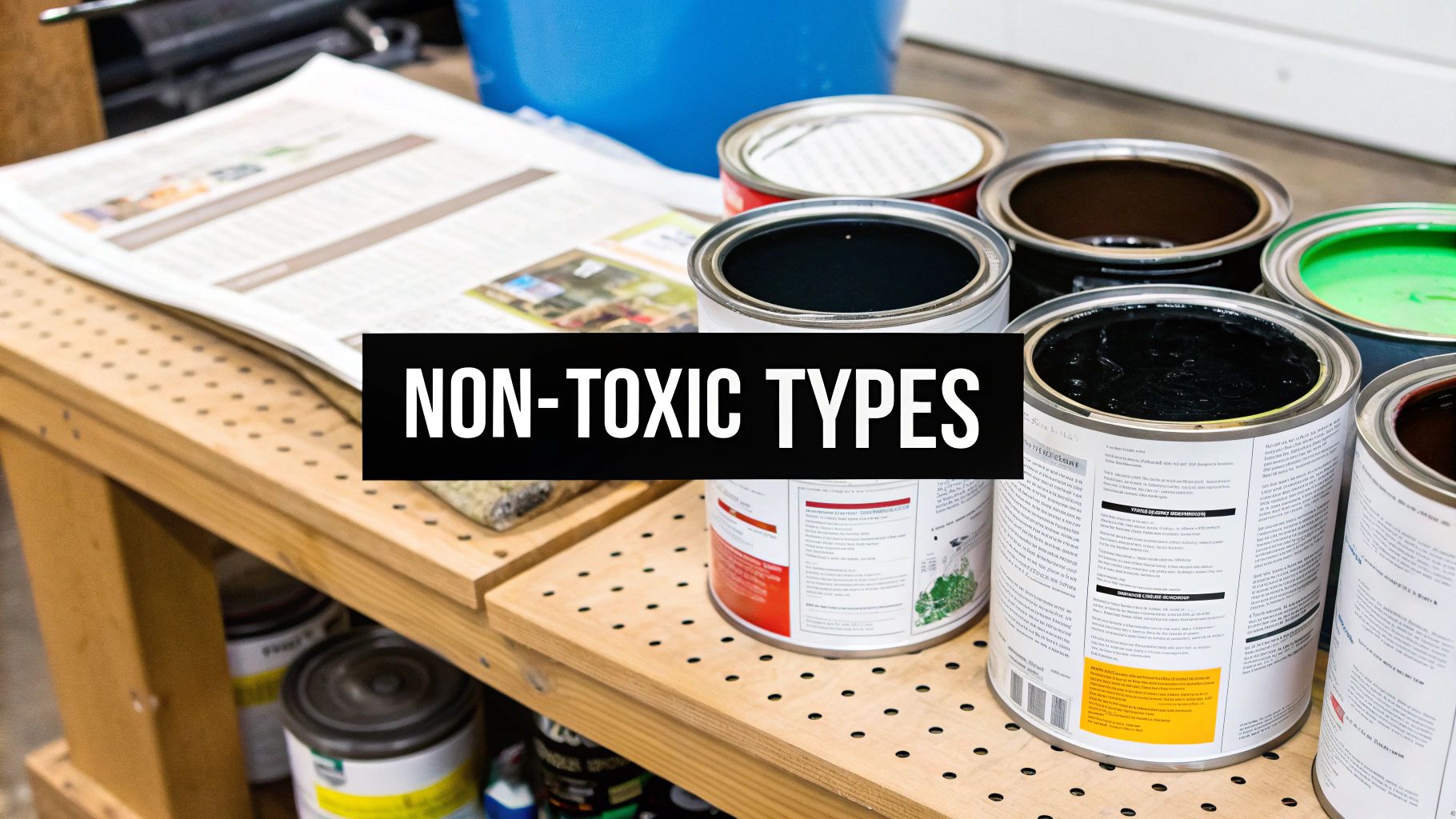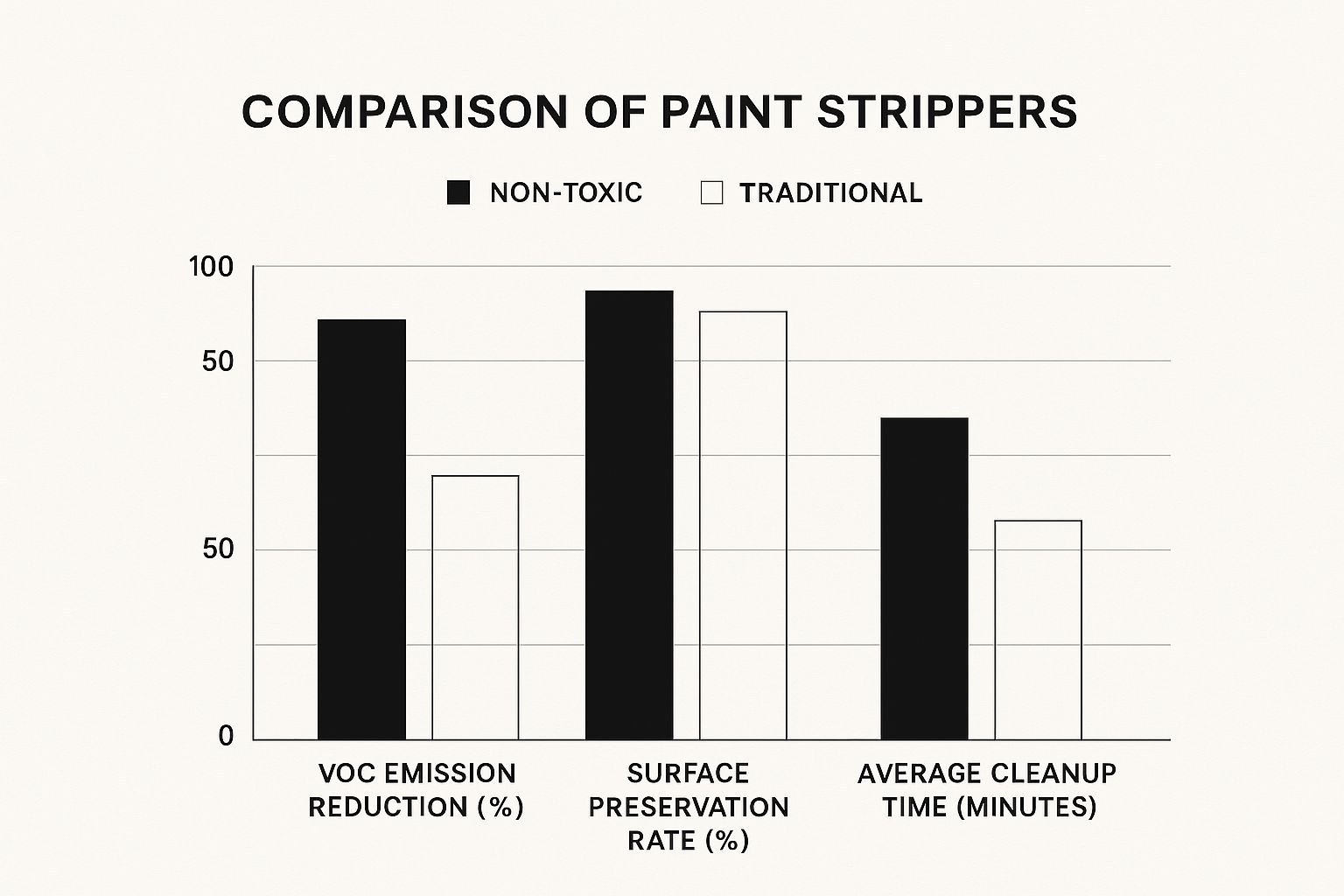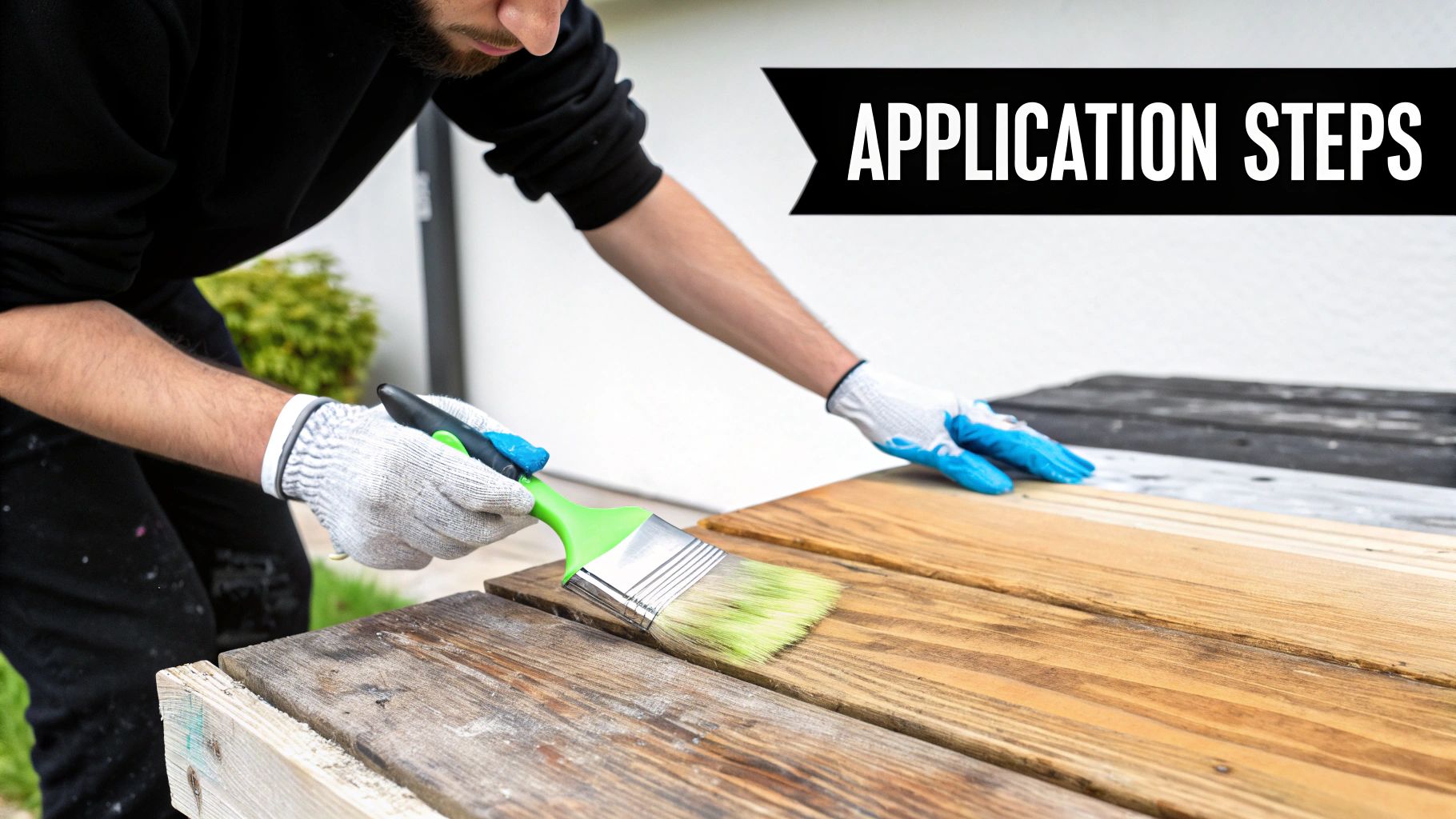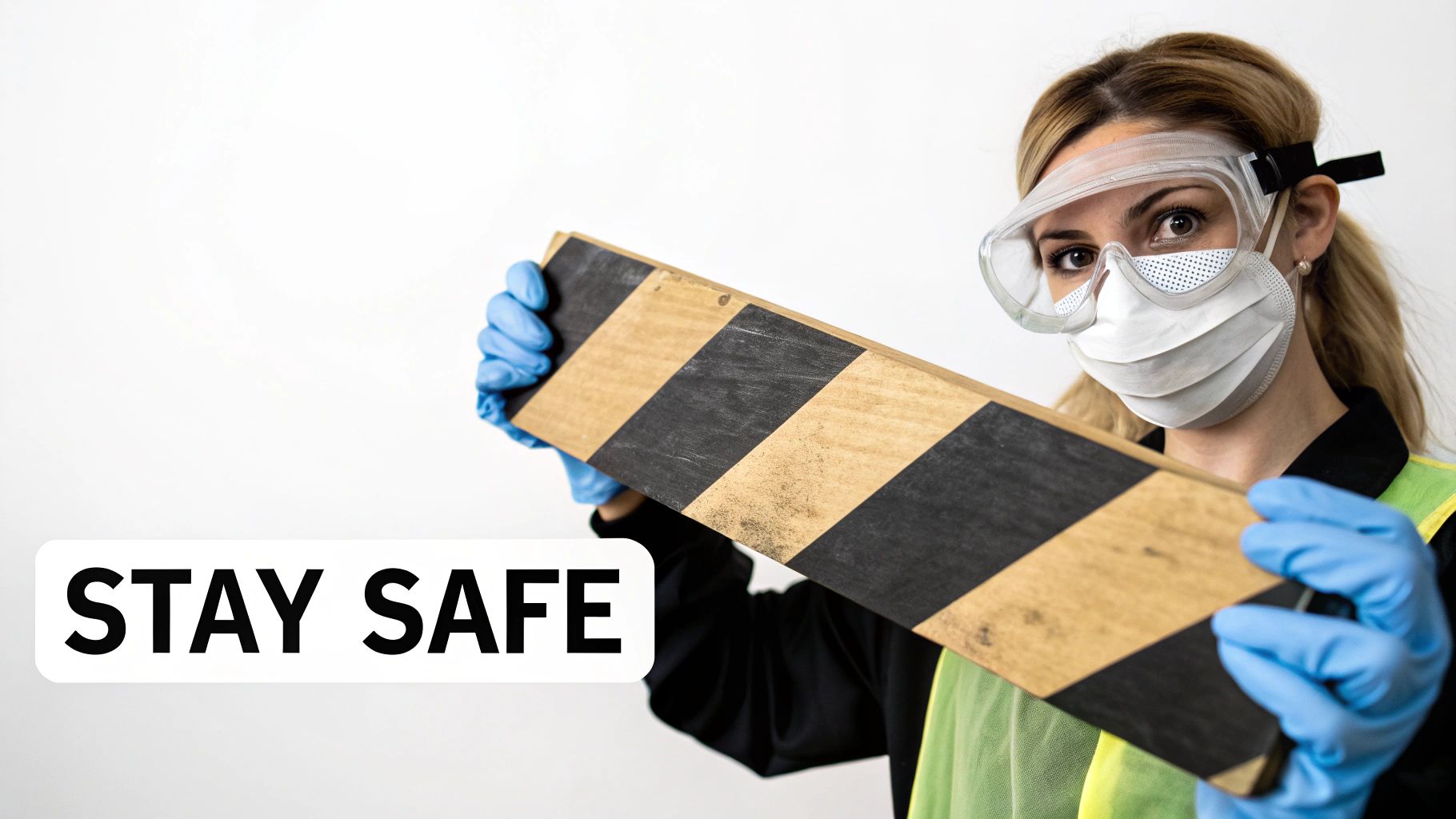Top Non Toxic Paint Stripping Tips for Safe Renovations
- Laserverse

- May 13
- 11 min read
The Hidden Dangers in Your Paint Removal Project
Conventional paint strippers often seem like the fastest way to tackle a messy project. However, these seemingly helpful products can pose significant health risks that are often overlooked. These dangers go beyond simple skin irritation and have prompted serious reevaluation within the industry.
Neurological and respiratory problems are among the most common issues linked to traditional paint strippers. Some chemicals found in these products can cause dizziness and headaches. Prolonged exposure can even lead to more serious neurological effects. Inhaling the fumes can also cause breathing difficulties, worsen existing respiratory conditions, and increase the risk of long-term lung damage. Simply wearing a mask might not be enough to prevent potential harm.
These risks are not just hypothetical; they pose real consequences for individuals. People have experienced severe adverse effects, ranging from acute respiratory reactions to chronic health problems after repeated exposure. Vulnerable populations, such as pregnant women, children, and people with pre-existing health conditions, face even greater risks. Standard safety measures might not fully protect these groups. You might be interested in: Our sitemap of other relevant articles.
The regulatory landscape, particularly in California, has changed dramatically regarding these hazardous chemicals. Methylene chloride in paint strippers has been a major public health concern. Since January 1, 2019, the California Department of Toxic Substances Control (DTSC) has listed these products as a Priority Product. Methylene chloride regulations effectively restrict its use in paint and varnish strippers due to its toxicity. This action emphasizes the seriousness of the issue and highlights the need for non-toxic paint stripping methods.
Understanding the Risks of Traditional Strippers
The presence of hazardous chemicals in conventional paint strippers underscores the need for awareness and caution. Many contain volatile organic compounds (VOCs), releasing harmful fumes into the air. These VOCs contribute to both immediate health problems and long-term environmental damage.
Protecting Yourself and the Environment
Choosing non-toxic paint stripping alternatives isn't just about personal safety; it's about environmental responsibility. Traditional strippers often contain harsh chemicals that can contaminate the air and soil. Switching to eco-friendly methods minimizes your environmental impact while still effectively removing paint. This choice contributes to a healthier planet and a safer future for everyone.
How Regulations Are Transforming Paint Stripping Safety
The world of paint stripping is undergoing significant changes, with regulations playing a vital role in enhancing safety for everyone involved in renovation projects. These changes directly affect product availability in California and how we approach our projects. Let's explore how consumer protection has become the driving force behind safer paint stripping practices.
The Methylene Chloride Ban: A Turning Point
A major shift in paint stripping safety occurred with the methylene chloride ban. Previously a common ingredient in many paint strippers, this chemical is now prohibited in consumer products. The Environmental Protection Agency (EPA) finalized this nationwide ban, impacting California directly, due to fatalities linked to methylene chloride exposure. From the ban's proposal in 2017 to its finalization in 2024, numerous deaths highlighted the urgent need for this action. The EPA's ban prevents the sale of methylene chloride-containing products in stores and online, prioritizing consumer safety. It also mandates notifications throughout the supply chain to ensure compliance and promote the adoption of non-toxic paint stripping methods. Learn more about this important regulation here. Safe project execution relies heavily on proper training. Access valuable resources for Health and Safety Training Materials.
The Impact on Product Availability and Formulation
These regulations have significantly affected product availability for California consumers. Many manufacturers have reformulated their paint strippers, removing methylene chloride and other hazardous chemicals. This has resulted in a wider selection of non-toxic paint stripping products on the market, ranging from citrus-based solvents to specialized tools for mechanical removal.
Enforcement and the Future of Paint Stripping
Enforcing these regulations is essential for consumer safety. The EPA actively monitors the market to ensure compliance with the methylene chloride ban. In California, with its strong emphasis on environmental protection, these efforts complement statewide initiatives to reduce the use of toxic chemicals. The DTSC has designated such products as a Priority Product, increasing scrutiny and enforcement. While this creates a complex marketplace, understanding the regulations empowers consumers to choose safer alternatives.

Heat-based methods and biochemical strippers are gaining popularity. These methods provide effective paint removal without the health risks associated with traditional chemical strippers. The shift toward safer practices benefits both consumers and the environment. By understanding the regulations and their impact, Californians can make informed decisions that protect their health and contribute to a sustainable future.
Breaking Down Non-Toxic Paint Stripping Options That Work
After discussing the dangers of traditional paint strippers and the increasing need for safer alternatives, let's explore effective non-toxic paint stripping options available for your California projects. We'll look beyond the marketing and dive into what truly works, providing practical insights for making informed decisions.
Biochemical Strippers: Harnessing Nature’s Power
Biochemical strippers use natural ingredients to break down paint, offering a safer alternative to harsh chemicals. These products often come in gel or paste form, making them easier to control on vertical surfaces and intricate details.
Citrus-Based Strippers: Excellent for delicate surfaces, like wood trim and antique furniture, citrus-based strippers are less likely to damage the underlying material. They use the power of citrus oils, like d-limonene, to lift the paint.
Soy-Based Strippers: Known for tackling multiple layers of paint effectively, soy-based strippers are a good option for larger projects or areas with thick, stubborn paint.
Heat-Based and Mechanical Methods: Tried and True Techniques
While biochemical strippers rely on chemical reactions, heat-based and mechanical methods offer different approaches to paint removal.
Heat Guns: Heat guns soften the paint, allowing you to scrape it away. They do, however, require practice to avoid scorching the surface. This method is best suited for flat surfaces and exterior projects.
Scraping and Sanding: Mechanical methods like scraping and sanding are effective, but can be labor-intensive and time-consuming. They're often paired with other methods for thorough paint removal.
Comparing Non-Toxic vs. Traditional Strippers
The infographic below highlights the key differences between non-toxic and traditional paint strippers, focusing on VOC emission reduction, surface preservation, and cleanup time.

As the data shows, non-toxic strippers significantly reduce VOC emissions, better preserve the underlying surface, and often require less cleanup. This makes them a healthier and more efficient option for your projects. Similar to how the food industry is adapting to regulations regarding PFAS, the paint stripping industry is transforming due to safety and environmental regulations. For more information on changes in food packaging, see this guide: PFAS Free Food Packaging.
To further break down the various non-toxic paint stripping methods, the following table offers a detailed comparison:
To help you choose the best non-toxic paint stripping method, the following table provides a comprehensive comparison of different methods, evaluating several key factors:
Comparison of Non-Toxic Paint Stripping Methods
Method | Effectiveness | Application Difficulty | Dwell Time | Cost Range | Best For | Limitations |
|---|---|---|---|---|---|---|
Citrus-Based Stripper | Moderate | Easy | Several hours | Low to moderate | Delicate surfaces, thin paint layers | May require multiple applications for thick paint |
Soy-Based Stripper | High | Easy to moderate | Several hours to overnight | Moderate | Multiple paint layers, thicker paint | Longer dwell times |
Heat Gun | High | Moderate to difficult | Varies depending on paint and surface | Moderate | Flat surfaces, exterior projects | Risk of scorching, not suitable for all surfaces |
Scraping | Moderate | Moderate to difficult | N/A | Low | Small areas, tight spaces | Labor-intensive, can damage surfaces if not careful |
Sanding | High | Moderate to difficult | N/A | Low to moderate | Smoothing surfaces, removing residual paint | Labor-intensive, creates dust |
This table summarizes the key characteristics of each method, allowing you to quickly compare and contrast their suitability for different projects. Consider the specific needs of your project when selecting a method, such as the type of material, the number of layers to remove, and the level of effort required.
Choosing the Right Method for Your Project
The ideal non-toxic paint stripping method depends on your individual project. Factors to consider include the type of surface, the number of paint layers, and your comfort level with different tools. For more information on laser cleaning, explore these laser cleaning products. Patience is essential when working with non-toxic strippers, as they typically require longer dwell times than traditional chemical strippers. However, the extra time is a worthwhile investment for the health and environmental benefits. Each method has its advantages, and understanding these nuances will help you achieve professional results while prioritizing safety and sustainability.
How California Pioneered Safer Paint Stripping Solutions
California has consistently led the charge in environmental regulations, and its proactive approach has significantly reshaped the paint stripping industry. The state's pursuit of safer alternatives has not only protected Californians but has also influenced product development and consumer preferences nationwide. This progressive stance has fostered innovation, leading to the creation of many effective, non-toxic paint stripping solutions.
From Regulation to Innovation: A Catalyst for Change
California's dedication to environmental protection created a unique market shift. As stricter regulations came into effect, manufacturers were compelled to adapt, resulting in a surge in the development and availability of non-toxic paint stripping products. This change wasn't simply a reaction to legal mandates; it signified a fundamental shift in how businesses addressed product formulation and consumer safety.
For instance, California's forward-thinking environmental policies, including the 2008 Green Chemistry Initiative, have driven comprehensive strategies to eliminate hazardous substances like methylene chloride from common consumer products, such as paint strippers. By 2014, six years after the initiative, California had detailed plans in place to remove these toxic chemicals from store shelves. Learn more about this initiative here. This dedication to safer products encouraged research and development, ultimately benefiting consumers across the country.
California Companies Leading the Way
Numerous California-based companies have played a key role in developing groundbreaking non-toxic paint stripping technologies. These companies recognized the changing landscape and invested in research and development to create effective and safer alternatives. Their innovations not only satisfied the new regulatory standards but also catered to the increasing consumer demand for environmentally responsible products. This proactive strategy has established California as a pioneer in the non-toxic paint stripping market.
Community Programs and Public Awareness
Along with regulatory changes and industry innovation, community programs have been essential in raising awareness about the hazards of traditional paint strippers and promoting the use of non-toxic options. These programs have offered valuable resources and education to both professionals and DIYers. This grassroots movement has been instrumental in driving market change and creating a safer environment for everyone.
A Model for the Nation
California's experience with non-toxic paint stripping provides important lessons for other states and even countries seeking to enhance consumer safety and environmental protection. The state's achievements demonstrate that strong regulations, combined with industry innovation and community involvement, can create significant positive change. This model can encourage similar initiatives globally, leading to wider adoption of safer, more sustainable practices in the paint stripping industry worldwide.

Your Non-Toxic Paint Stripping Playbook: From Prep to Finish

So, you're ready to strip paint without harsh chemicals in your California home? Excellent! Proper preparation is essential for professional-looking results. This guide will walk you through the process, ensuring a smooth and successful paint removal project.
Essential Prep Work: Setting the Stage for Success
Just like a chef preps ingredients, you need to prepare your surfaces. This initial step, though often overlooked, greatly impacts the effectiveness of your chosen non-toxic method.
Lead Testing: In homes built before 1978, lead paint testing is vital. Lead paint demands specific removal procedures to avoid health risks. If lead is detected, contact a certified lead abatement professional.
Surface Assessment: Determine the surface type (wood, metal, plaster, etc.). This helps you choose the right non-toxic stripping method. For instance, delicate surfaces require gentler options like citrus-based strippers.
Protection and Ventilation: Protect surrounding areas with drop cloths and ensure adequate ventilation by opening windows. This minimizes exposure to any fumes and maintains a safe workspace.
To help you visualize the process, we've outlined a typical timeline:
To help you visualize the process, we've outlined a typical timeline:
Non-Toxic Paint Stripping Process Timeline
Project Stage | Estimated Time | Key Considerations | Tips for Efficiency |
|---|---|---|---|
Lead Testing (if applicable) | 1-2 days | Hire a certified professional for accurate results | Schedule testing early in the process |
Surface Preparation | 1-2 hours | Thoroughly clean and protect surrounding areas | Gather all necessary materials beforehand |
Stripper Application | 30-60 minutes | Apply a thick, even coat following manufacturer's guidelines | Use appropriate applicators |
Dwell Time | 4-24 hours | Varies depending on the product and paint layers | Monitor progress periodically |
Paint Removal | 1-4 hours | Use appropriate scraping tools | Work in sections |
Clean Up | 1-2 hours | Dispose of waste properly | Follow local regulations |
This timeline provides a general overview and can vary based on project specifics. Remember to consult the manufacturer’s instructions for your chosen stripper.
Applying Non-Toxic Strippers: Techniques for Maximum Effectiveness
Choosing the right stripper is only half the battle; applying it correctly is equally important. Understanding each formulation is crucial for optimal paint removal.
Application Thickness: Apply a thick, even layer of the non-toxic stripper, adhering to the manufacturer's instructions. This saturates the paint for efficient removal.
Temperature Considerations: Ideal temperatures boost the stripper's effectiveness. Check the product label for recommended temperature ranges, typically between 60°F and 80°F.
Dwell Time Optimization: Give the stripper enough time to work. This typically ranges from a few hours to overnight, depending on the product and the paint's thickness.
Tackling Challenging Scenarios: Expert Tips and Tricks
Some situations require specialized techniques for effective non-toxic paint stripping.
Intricate Moldings: Use a small brush or cotton swab to apply stripper to detailed areas. This precision prevents dripping and ensures full coverage.
Vertical Surfaces: Choose thicker, gel-like strippers that adhere to vertical surfaces without running. This prevents waste and optimizes paint removal on walls and other upright structures.
Stubborn Multi-Layer Finishes: For thick, layered paint, consider multiple stripper applications or a stronger formulation. Mechanical methods like scraping or sanding may be necessary for complete removal.
Cleanup and Safety: Maintaining Eco-Friendly Integrity
Keeping your project eco-friendly includes proper cleanup. Correctly dispose of stripped paint and cleaning materials, especially if lead paint is involved. Follow local regulations for hazardous waste disposal.
Troubleshooting and Expert Solutions: Addressing Common Issues
Even with careful preparation, you might encounter some hiccups. Here are solutions for common issues:
Stripper Not Working: Verify proper surface preparation, sufficient dwell time, and correct temperature. If the paint remains stuck, try a different non-toxic stripper.
Uneven Paint Removal: Apply multiple coats or use mechanical methods on stubborn areas to achieve uniform stripping.
Surface Damage: Use gentle, non-abrasive tools for scraping to avoid damaging the underlying material. Always test the stripper on a hidden area before applying it fully.
This guide equips you with the knowledge and techniques for successful non-toxic paint stripping. Patience and attention to detail are key. By following these steps and prioritizing safety, you can achieve professional-looking results while being environmentally responsible.
Real Projects, Real Results: Non-Toxic Success Stories
After exploring the preparation and processes of non-toxic paint stripping, let's examine some practical applications. These case studies showcase the effectiveness of non-toxic methods in various California renovation projects, highlighting the real-world benefits and offering inspiration for your own work.
Restoring a Victorian Gem in San Francisco
This project involved stripping multiple layers of paint from the intricate woodwork of a historic Victorian home. Due to the wood's delicate nature and the risk of damage, conventional methods were unsuitable. A citrus-based stripper was chosen for its gentler properties.
Products Used: A citrus-based stripping gel and wooden scrapers.
Application Technique: Thick coats of the gel were applied and allowed to dwell overnight before being carefully scraped away.
Timeline: The entire process, including preparation, stripping, and cleanup, took three days.
Challenges: The detailed woodwork demanded meticulous application and removal of the stripping gel.
Results: The non-toxic stripper successfully removed the paint without harming the intricate carvings, revealing the original wood's beauty.
Reviving Mid-Century Modern Furniture in Palm Springs
This project focused on restoring a set of mid-century modern chairs. The objective was to remove the old finish and expose the original wood grain. Because of the chairs' vintage value, a soy-based stripper was selected for its effectiveness and minimal impact.
Products Used: A soy-based stripping paste, fine-grit sandpaper, and a natural wood finish.
Application Technique: The paste was applied evenly and left for several hours before being scraped away. Light sanding and a natural finish completed the restoration.
Timeline: Each chair required approximately one day to strip and refinish.
Challenges: Ensuring even application and removal of the stripper on the chairs' curved surfaces presented a challenge.
Results: The soy-based stripper effectively removed the old finish without damaging the wood, allowing the chairs’ original beauty to shine.
Removing Graffiti From a Brick Wall in Los Angeles
This project tackled graffiti removal from a historic brick wall in Los Angeles. The key was to remove the paint without harming the soft, porous brick. A combination of a biochemical stripper and a low-pressure washer proved effective.
Products Used: An eco-friendly graffiti remover, a low-pressure washer, and a protective sealant.
Application Technique: The graffiti remover was applied and allowed to dwell before being gently washed away with the low-pressure washer. A sealant was then applied for protection and to prevent future graffiti.
Timeline: The complete process, including preparation, removal, and sealing, took two days.
Challenges: The main challenge was achieving complete graffiti removal without damaging the underlying brick.
Results: The combined methods successfully removed the graffiti while preserving the integrity of the historic brick wall.
These diverse projects demonstrate the versatility and effectiveness of non-toxic paint stripping techniques. From delicate Victorian woodwork to stubborn graffiti, these solutions offer professional results while prioritizing health and environmental responsibility. Whether you're a professional restorer or a DIY enthusiast, consider these methods for your next project. Learn more about Laserverse’s innovative laser cleaning technology for efficient and eco-friendly paint removal in California: Explore Laserverse

